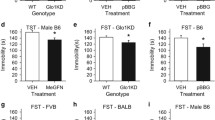Abstract
The effects of monoamine oxidase inhibitors (MAOIs) that selectively inhibit the MAO-A or MAO-B forms of MAO were studied in rats performing under a differential-reinforcement-of-low-rate 72-s (DRL 72-s) schedule of reinforcement. Clorgyline and CGP11′305A, irreversible and reversible MAO-A inhibitors, respectively, increased the reinforcement rate, decreased the response rate, and enhanced temporal discrimination. The irreversible MAO-B inhibitor (−)-deprenyl did not produce similar effects. Pargyline did not increase the reinforcement rate at low doses that selectively inhibit MAO-B, but did increase the reinforcement rate at doses that inhibit MAO-A by more than 90%. The present results are in accord with clinical data demonstrating that MAO-A inhibitors are effective therapeutic agents in treating depression while MAO-B inhibitors are of questionable antidepressant efficacy. The present findings provide further evidence that the DRL 72-s schedule may be useful both as a screen for identifying new antidepressants and for investigating the neurochemical effects of antidepressant drugs that are responsible for their therapeutic effects.
Similar content being viewed by others
References
Aarons SF, Mann JJ, Brown RP, Young RB, Frances A (1985) Antidepressant efficacy of l-deprenyl: clinical and biochemical correlates. In: Burrows GD, Norman TR, Dennerstein L (eds) Clinical and pharmacological studies in psychiatric disorders. Libbey, London Paris, pp 33–36
Christmas AJ, Coulson CJ, Maxwell DR, Riddell D (1972) A comparison of the pharmacological and biochemical properties of substrate-selective monoamine oxidase inhibitors. Br J Pharmacol 45:490–503
Colton T (1974) Statistics in medicine. Little, Brown and Co, Boston, Mass
Finberg JPM, Youdim MBH (1983) Selective MAO A and B inhibitors: their mechanism of action and pharmacology. Neuropharmacology 22:441–446
Fuentes JA, Neff NH (1975) Selective monoamine oxidase inhibitor drugs as aids in evaluating the role of type A and B enzymes. Neuropharmacology 14:819–825
Green AR, Youdim MBH (1975) Effects of monoamine oxidase inhibition by clorgyline, deprenil or tranlcypromine on 5-hydroxytryptamine concentrations in rat brain and hyperactivity following subsequent tryptophan administration. Br J Pharmacol 55:415–422
Howard JL, Pollard GT (1984) Effect of imipramine, bupropion, chlorpromazine and clozapine on differential-reinforcement-of-low-rate (DRL) greater than 72-s and greater than 36-s schedules in rat. Drug Dev Res 4:607–616
Johnson JP (1968) Some observations upon a new inhibitor of monoamine oxidase in brain tissue. Biochem Pharmacol 17:1285–1297
Lipper S, Murphy DL, Slater S, Buchsbaum MS (1979) Comparative behavioral effects of clorgyline and pargyline in man: a preliminary evaluation. Psychopharmacology 62:123–128
Marek GJ, Seiden LS (1988) Effects of selective 5-HT2 and non-selective 5-HT antagonists on the differential-reinforcement-of-low-rate 72-s schedule. J Pharmacol Exp Ther (in press)
Maxwell RA, White HL (1978) Tricyclic and monoamine oxidase inhibitor antidepressant: structure-activity relationships. In: Iversen LL, Iversen SD, Snyder SH (eds) Affective disorders: drug actions in animals and man. Handbook of psychopharmacology 14. Plenum Press, New York, pp 83–124
McGuire PS, Seiden LS (1980) The effects of tricyclic antidepressants on performance under a differentialreinforcement-of-low-rates schedule in rats. J Pharmacol Exp Ther 214:635–641
Mendis N, Pare CMB, Sandler M, Glover V, Stern GM (1981) Is the failure of (−)-deprenyl, a selective monoamine oxidase B inhibitor, to alleviate depression related to freedom from the cheese effect. Psychopharmacology 73:87–90
Mendlewicz J, Youdim MBH (1983) l-Deprenil, a selective monoamine oxidase type B inhibitor, in the treatment of depression: a double blind evaluation. Br J Psychiatry 142:508–511
Murphy DL, Lipper S, Slater S, Shiling DJ (1979) Selectivity of clorgyline and pargyline as inhibitors of monoamine oxidases A and B in vivo in man. Psychopharmacology 62:129–132
O'Donnell JM (1987) Effects of clenbuterol and prenalterol on performance during differential reinforcement of low response rate in the rat. J Pharmacol Exp Ther 241:68–75
O'Donnell JM, Seiden LS (1982) Effects of monoamine oxidase inhibitors on performance during differential reinforcement of low response rate. Psychopharmacology 78:214–218
O'Donnell JM, Seiden LS (1983) Differential-reinforcement-of-low-rate 72-s schedule: selective effects of antidepressant drugs. J Pharmacol Exp Ther 224:80–88
Pare CMB (1985) The present status of monoamine oxidase inhibitors. Br J Psychiatry 146:576–584
Pearl RG, Seiden LS (1976) The existence of tolerance to and cross-tolerance between d-amphetamine and methylphenidate for their effects on milk consumption and on differential-reinforcement-of-low-rate performance in the rat. J Pharmacol Exp Ther 198:635–647
Philips SR (1981) Amphetamine, p-hydroxyamphetamine and β-phenethylamine in mouse brain and urine after (−)- and (+)-deprenyl administration. J Pharm Pharmacol 33:739–741
Pollard GT, Howard JL (1986) Similar effects of antidepressant and non-antidepressant drugs on behavior under an interresponse-time greater than 72-s schedule. Psychopharmacology 89:253–258
Seiden LS, O'Donnell JM (1985) Effects of antidepressant drugs on DRL behavior. In: Seiden LS, Balster RL (eds) Behavioral pharmacology: the current status. Liss, New York, pp 323–338
Seiden LS, Dahms JL, Shaughnessy RA (1985) Behavioral screen for antidepressants: the effects of drugs and electroconvulsive shock on performance under a differential-reinforcement-of-low-rate schedule. Psychopharmacology 86:55–60
Snapper AG, Stephens KR, Cobez RI, Van Haaren F (1976) The SKED software systems: OS8 and Time Share SKED. State Systems, Kalamazoo, Mich
Taylor KM, Snyder SH (1970) Differential effects of d- and l-amphetamine on behavior and on catecholamine disposition in dopamine and norepinephrine containing neurons of rat brain. Brain Res 28:295–309
Wheatley D (1970) Comparative trial of a new mono-amine oxidase inhibitor in depression. Br J Psychiatry 117:573–574
Winer BJ (1971) Statistical principles in experimental design. McGraw-Hill, New York
Yoshida I, Yamada Y, Yamamoto T, Kuroiwa Y (1986) Metabolism of deprenyl, a selective monoamine oxidase (MAO) B inhibitor in rat: relationship of metabolism of MAO-B inhibitory potency. Xenobiotica 16:129–136
Youdim MBH, Finberg JPM, Tipton KF (1983) Monoamine oxidase. In: Trendelenburg U, Weiner N (eds) Catecholamine II. Handbook of experimental pharmacology
Author information
Authors and Affiliations
Rights and permissions
About this article
Cite this article
Marek, G.J., Seiden, L.S. Selective inhibition of MAO-A, not MAO-B, results in antidepressant-like effects on DRL 72-s behavior. Psychopharmacology 96, 153–160 (1988). https://doi.org/10.1007/BF00177554
Received:
Revised:
Issue Date:
DOI: https://doi.org/10.1007/BF00177554




